Alpine, New Jersey, June 11, 2005
For a radio geek and a history buff, there are a few places in the
country that go beyond the merely interesting to the truly special.
Mount Washington, New Hampshire is one such place; the WTIC
transmitter in Avon, Connecticut is another. But the Holy Grail of
radio history must surely be the laboratories of Major Edwin Howard
Armstrong, who single-handedly created three of the 20th century's
most important inventions: the regenerative circuit (a tube-based
amplifier and oscillator circuit), the superheterodyne circuit (still
the basis of nearly all radio receivers built since the 1930s), and
most significant of all, frequency modulation.
Armstrong never received his due during his lifetime -- a lifetime
of engineering genius which was tragically cut short by Armstrong's
suicide on January 31, 1954, at a low point in one of his long-running
patent fights. Thankfully, a few dedicated people in the engineering
community have kept Armstrong's fight for his proper historical
recognition (as opposed to the self-invented histories of men like
Sarnoff and de Forest, who would have had Armstrong remembered as a
crazy tinkerer). Among these people are Steve Hemphill, owner of
Solid Electronics Labs of Philadelphia, and Charles Sackermann,
principal of CSC
Management, the company which owns Armstrong's physical
legacy -- the great three-armed tower and laboratory Armstrong built
in Alpine, New Jersey.
On January 31, 2004, the fiftieth anniversary of Armstrong's death,
Hemphill and other Armstrong afficionados gathered to remember the
Major and his contributions -- FM foremost among them. What better
way to remember the inventor of FM than to build an FM transmitter to
Armstrong's original specifications, and get FCC permission to operate
it (if only temporarily) on one of Armstrong's channels? Since the
old FM band was reallocated to public safety, and most of those users
had migrated to more-predictable spectrum in the UHF band, it might be
possible to use those frequencies again. Hemphill, who had the
engineering and design qualifications and access to salvaged
components from old tube transmitters, decided to have a go at
building a Phasitron FM transmitter.
In the course of his research, Steve found out that the first
public demonstration of FM by Armstrong took place in November of
1935, soon after Armstrong built his laboratory and massive tower in
Alpine, New Jersey. He got in touch with the current owners of the
site, CSC Management, and found in CSC's president, Chuck Sackermann, a
man with equal dedication to the memory of the Major. CSC could have
imploded the unique Armstrong tower long ago, and replaced it with a
more conventional structure with more leasable space; they chose
instead not only to maintain it, but to restore Armstrong's laboratory
building (which had had many uses since Armstrong's death, including
for a time in the 1980s USA Network's master control). Since 9/11,
CSC has fought with the Johnny-come-lately neighbors in Alpine and
Closter to improve the facility to provide emergency facilities for
New York's broadcasters, including, ironically, WNBC-TV.
With the original transmitter site available, Hemphill was able to
get Experimental Special Temporary Authority to operate wideband FM on
44.1 MHz with 250 watts from Alpine, under the callsign WB3XXE. Scott
and I saw the facility demonstrated at the monthly SBE meeting in
January, 2005; that evening, the Sackermann family announced plans for
an official commemoration to be held later that year.
By the date of the celebration, Steve had received FCC approval to
retune his transmitter to Armstrong's original frequency, 42.8 MHz,
under the new callsign WA2XMN -- recalling Armstrong's original
callsign, W2XMN. (Armstrong's station also operated on the new FM
band, at 93.1 MHz, under the callsign KE2XCC.)
WA2XMN now has a full five-year experimental license. Keep on
monitoring 42.8!
The galleries for this trip are organized by state:
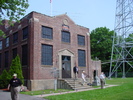 |
| Armstrong's laboratory, Alpine |
|
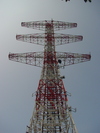 |
| Armstrong's tower |
|
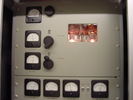 |
| Hemphill's transmitter |
|
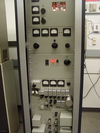 |
| WA2XMN |
|
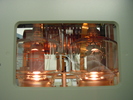 |
| WA2XMN glowing PA tubes |
|
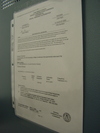 |
| WA2XMN license |
|
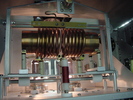 |
| Back side of WA2XMN |
|
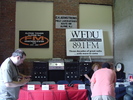 |
| Setup for panel |
|
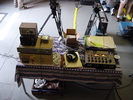 |
| WA2XMN master control |
|
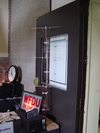 |
| Scale model of antenna |
|
 |
| Stromberg-Carlson console |
|
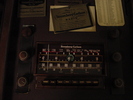 |
| Tuning dial |
|
 |
| Tivoli Model One |
|
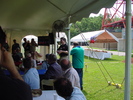 |
| WA2XMN is on the air |
|
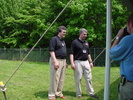 |
| Steve Hemphill and Chuck Sackermann |
|
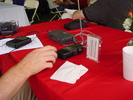 |
| Airchecking 42.8 |
|
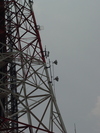 |
| WFDU antenna |
|
 |
| WNBC backup |
|
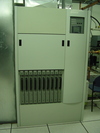 |
| WNET backup |
|
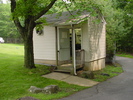 |
| WFDU tx bldg. |
|
 |
| One more shot... |
|
Copyright 2005 Garrett Wollman. All rights reserved.




















